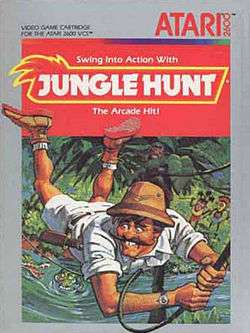Jungle Hunt
| Jungle Hunt | |
|---|---|
 | |
| Developer(s) |
Taito Atari (ports) |
| Publisher(s) |
Taito Atari (ports) |
| Platform(s) |
Arcade (original) Apple II, Atari 2600, Atari 5200, IBM PC, Atari 8-bit, ColecoVision, C64, VIC-20 |
| Release date(s) |
Jungle King |
| Genre(s) | Side-scroller |
| Mode(s) | 1-2 players alternating |
| Cabinet | Upright |
| CPU | Z80 |
| Sound | AY-3-8910, DAC |
| Display | Raster, standard resolution 256x224 (60Hz) |
Jungle Hunt (ジヤングル・ハン卜) is a right-to-left side-scrolling arcade game produced and released by Taito in 1982. It was initially released as Jungle King. Jungle Hunt is one of the first video games to use parallax scrolling.
The player controls an unnamed explorer, sporting a pith helmet and safari suit, attempting to rescue his girl from a tribe of cannibals by swinging from vine to vine, swimming a crocodile-infested river, and avoiding rolling rocks. Taito released a re-skinned version of the game as Pirate Pete.[2]
Atari published home ports under their own brand for the Atari 2600, Atari 5200, and Atari 8-bit family. The rest were released under the Atarisoft label: Apple II, ColecoVision, Commodore 64, VIC-20, IBM PC (as a PC booter), and TI-99/4A. It was re-released, via emulation, as part of Taito Legends for Windows, PlayStation 2, and Xbox.
In the Atari-ported versions the hero is named Sir Dudley, and the girl, married to Sir Dudley, is Lady Penelope.
History
Jungle Hunt changed names several times during development. The original prototypes were called Jungle Boy and later became Jungle King for release to the arcades.[3] In these earlier versions the playable character was a bare-chested man with a loincloth who resembled Tarzan.
Taito were sued by the Edgar Rice Burroughs estate for copyright infringement for using the character's likeness. This led to a rerelease as Jungle Hunt,[4] with the following changes made to the game:
- The character was replaced with a jungle explorer wearing a pith helmet and safari outfit.
- In the first scene, ropes replace the vines as the objects that the player has to swing on.
- The Tarzan yell was removed and cannot be heard throughout the game. It was replaced by the music from the end of the second scene.
Taito Brazil (Taito do Brasil) released a version of the game in 1983, also under the title Jungle Hunt, which included the bare-chested character and the Tarzan yell.
Gameplay
The gameplay is split into four scenes, which have different objectives.
In Scene 1, the explorer is required to swing from vine to vine. This is accomplished by pressing the action key when two vines swing closely enough together. Timing is critical, and missing the vine causes the explorer to fall to the jungle floor, losing a life.
Scene 2 has the explorer navigating a crocodile-infested river. The explorer can attack the crocodiles from below with his knife, unless their mouths are open. The explorer must return to the surface periodically to breathe, where he cannot attack the crocodiles. Bubbles periodically rise from the bottom of the river, which can trap the explorer and carry him to the surface, potentially hitting crocodiles on the way.
Scene 3 involves the explorer dodging various-sized boulders rolling and bouncing towards him as he runs up the side of a volcano. Timing is critical as the differently sized boulders bounce at different speeds and heights, and the explorer can be trapped between them.
In the final scene, the explorer must evade cannibals while attempting to get to a woman being lowered into a flaming cauldron. After the player rescues the woman, the word "Congratulations!" appears, which is then followed by a message saying "I Love You!!!" followed by the woman kissing the explorer.
Further gameplay repeats the scenes with increased difficulty. On rounds other than the first, a cannibal appears in the tree of the cauldron scene and throws spears at the player.[5]
Reception
Jungle Hunt was well received, gaining a Certificate of Merit in the category of "1984 Best Adventure Videogame" at the 5th annual Arkie Awards.[6]:42
References
- ↑ Fujihara, Mary (1983-07-25). "Inter Office Memo". Atari. Retrieved 18 March 2012.
- ↑ "Pirate Pete"
- ↑ "Jungle King / Jungle Boy"
- ↑ "Jungle Hunt"
- ↑ Jungle Hunt at the Killer List of Videogames
- ↑ Kunkel, Bill; Katz, Arnie (January 1984). "Arcade Alley: The Arcade Awards, Part 1". Video. Reese Communications. 7 (10): 40–42. ISSN 0147-8907.